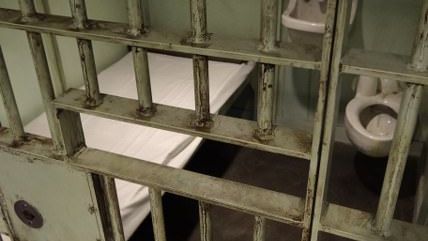Solitary Confinement and Its Costs
Our correctional institutions have made ever-increasing use of solitary confinement, a policy that is damaging and potentially catastrophic.

After journalist Terry Anderson was taken hostage by a terrorist group in Lebanon in 1985, he spent much of six years in tiny cells completely by himself. Trapped in solitude, he found his mind inexorably breaking down.
"Where are all the things I learned, the books I read, the poems I memorized?" he asked himself. "There's nothing there, just a formless, gray-black misery. My mind's gone dead."
At times he was put with other captives, which he found far preferable. But in 1986, he was returned to solitary confinement, and soon he hit the end of his rope. He began smashing his head into the wall, over and over, until his jailers stopped him. Even after his release from captivity, he told The New Yorker magazine, he felt himself enveloped in a mental fog.
For many American prison inmates, detention in a tiny space with minimal human contact is routine and unending. They may spend 22 or 23 hours a day in a cell measuring six feet by eight feet. When they are let out for exercise, they may also be alone. Like Anderson, they may descend into despair or madness.
In recent decades, our correctional institutions have made ever-increasing use of solitary confinement. By 2005, more than 80,000 prisoners were held this way. The total exceeds that of any other country in the democratic world.
But the tide may be turning. On Wednesday, the New York state government reached a settlement banning the use of extreme isolation for juveniles and limiting it for adults. Other states are reassessing the practice, and Tuesday, U.S. Sen. Dick Durbin, D-Ill., will convene a hearing on it.
This is not the first time Americans have gone through this learning sequence. The use of isolation originated in this country in the early 19th century, with the purpose of spurring criminals to reflect on their misdeeds and repent.
Stuart Grassian, a psychiatrist and former professor at Harvard Medical School, writes that the results were "catastrophic. The incidence of mental disturbances among prisoners so detained, and the severity of such disturbances, was so great that the system fell into disfavor and was ultimately abandoned."
Americans of that era eventually saw that isolating prisoners was not only inhumane but self-defeating, making criminals worse instead of better. Even the Supreme Court, which was not dominated by liberal activists when it addressed the matter in 1890, expressed grave objections.
But less than a century later, all of that was forgotten in a frenzy of tough-on-crime measures, including "supermax" prisons that imposed extreme isolation on the worst offenders—and, in the words of a federal court, skirted "the edge of what is humanly tolerable for those with normal resilience."
Many inmates find the experience beyond the edge of tolerability. The most vulnerable ones "suffer from states of florid psychotic delirium, marked by severe hallucinatory confusion, disorientation … and by intense agitation and paranoia," wrote Grassian in the Washington University Journal of Law and Policy.
Even the strongest individuals, he noted, "will experience a degree of stupor" as well as "obsessional thinking, agitation, irritability, and difficulty tolerating external stimuli." Inmates in solitary, a study found, are seven times more likely to commit suicide than similar prisoners in normal cells. For those who survive, the emotional effects can last for decades.
Politicians may be disinclined to worry about the use of extreme isolation, much less to take action to improve the treatment of criminals. But there are at least two good reasons for the law-abiding citizenry to care.
The first is cost. Housing a prisoner in isolation costs as much as sending him to Harvard—about $60,000 a year, at least double the expense of normal incarceration. This policy is one reason states now spend eight times as much on corrections as they did 30 years ago.
The second reason is that most of these inmates won't be incarcerated forever. The vast majority will be released back into society. Extreme isolation is about the worst possible training for living and working peaceably among others.
That is a problem, and not only for the ex-convict. Every day, someone who was held in solitary confinement and may be suffering from agitation, irritability and difficulty tolerating external stimuli leaves prison. And the external stimuli he can't tolerate could be you.
Editor's Note: As of February 29, 2024, commenting privileges on reason.com posts are limited to Reason Plus subscribers. Past commenters are grandfathered in for a temporary period. Subscribe here to preserve your ability to comment. Your Reason Plus subscription also gives you an ad-free version of reason.com, along with full access to the digital edition and archives of Reason magazine. We request that comments be civil and on-topic. We do not moderate or assume any responsibility for comments, which are owned by the readers who post them. Comments do not represent the views of reason.com or Reason Foundation. We reserve the right to delete any comment and ban commenters for any reason at any time. Comments may only be edited within 5 minutes of posting. Report abuses.
Please to post comments




What contributes to that price tag? I've heard a lot of stats about the dollar cost of operating a crimal warehousing facility, but no one ever breaks down where the dollars go.
That was my first question. I'm guessing a lot of that is made up of the salaries of the various corrections officers and such who maintain the solitary confinement area.
I'm sure that a lot of it is people who would have been paid anyway.
Numbers like that are never honest.
OK, but what is Warty's take on solitary confinement?
He didn't appreciate the time spent trapped in the lab, but we eventually found the dosages required to sedate him and conduct our tests. However, as an endangered species, we were required to release him back into the wild. He destroyed the tracking collar not long thereafter.
How long will it take to sterilize the lab so that its fit for human use or will it just be buried under yards of concrete with warning signs for future generations?
Concrete and lead, I should hope.
And when Warty doesn't appreciate something, expect a lot of organs to be expelled through anuses.
My heart is breaking for these poor prisoners being forced to live in solitary confinement. I would think it would be considered a privilege to get their own space.
There are some rather obvious benefits to solitary confinement.
- No prison rapes.
- No prison gangs.
- No prison gang tattoos (that limit future employability).
- Healthier prisons (reduced spread of HIV and Hepatitis).
And if we agree that time in solitary confinement is greater punishment than time in general population, then make it a 50% shorter sentence (1 yr instead of 2), and reduce the overall prison population by 50%.
Personally, if I were sent to prison, I'd prefer my own private room.
NoLess prison rapes.
You mean fewer. If you're going to correct someone you should at least correct them correctly.
*hangs head in shame*
First, the author claims 80,000 prisoners kept in solitary confinement as if that is a static number-it is not. Prisoners move in and out of isolation for a variety of behavior issues such as, committing murder or felony assault within the prison; committing rape within the prison; gang crime activity; planning escapes; mental illness that is dangerous to themselves or other; attacking guards or support staff, and by the inmate's request (See, Birdman of Alcatraz).Second, the total inmate population nationally is less than 1% and those held in isolation a fraction thereof. Third, the inmates manipulate and play the psychiatrists, psychologists, counselors, and other staff-especially the lawyers!
The current cost to build a bed-space in a jail or prison is about $100,000. Guard staff make approximately $30-$60,000 annually, benefits included. The government-state or federal sets the ratio of guards to inmate population-usually 1 guard for every 3-5 inmates. The government also sets the amount of inmate space, how many mental health professionals, how many medical and other staff depending on inmate population of a particular facility. There is much waste that could be reduced throughout this system, but many benefit from the establishment. There are some exceptions to the above figures, but they are, in general current.
Your staff pay is way off for a place like California. 2x what you quoted.
The average prison inmate typically had to "work hard" to get there. There is always an exception, but most people sentenced to prison have a long predatory career of committing crimes against you or your neighbors. The inmate sentenced to 30 years or longer for murder has horrifically taken someone else's life. The method is usually gruesome with the victim(s) suffering agony prior to death. The family that has their home burglarized, their personal stuff rummaged through, and their life-savings or family heirlooms stolen feel as if they have been personally raped. Concern should be for the victims of these crimes-not so much for those that did them.
Solitary Confinement is Groovy!!
Thoreau, is that you? Somehow I don't think so. What have you done with Thoreau?
Concern should be for the victims of these crimes-not so much for those that did them.
How are the victims made whole by charging them via taxation for the room and board of their assailants? How are the criminals "paying for their crime" with free room and board? Who is collecting this "payment" and how can it be transferred to the victim, so that they can be made whole?
I find it hard to believe it costs more to keep someone isolated than in population. With solitary you can easily have fewer guards watching far more stationary cells, it's not like isolated prisoners are able to knife or rape each other. Isolation is generally done (at least I'd like to think) either as punishment (they're in prison already, what else you gonna do, whip them?) or to protect the isolated prisoner or the other prisoners/guards. This sounds like protesting that a rabid dog isn't being allowed out in the play area with the other dogs and handlers.
Good article.
And obd2life.com is a good obd2 supplier. It provides high quality obd2 tools,like SBB Key Programmer V33.
Its really obvious when the cops start trolling here. "AUTHORITY DOESNT MAKE MISTAKES" "CRIMINAL SCUM DESERVE WHAT THEY GET" "LAW ENFORCEMENT IS COST EFFECTIVE"
leave, please, you won't find converts here.
BuckyBall neo cube magnetic building toy is exquisite, combinatory, glossy and it's not easy to fade. So it can be used as magnetic jewelry, such as necklaces, bracelets.